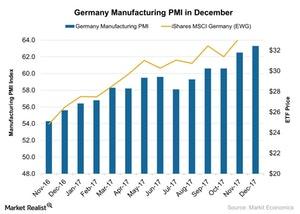Germany’s Manufacturing Activity Reaches a Multidecade High
Germany’s manufacturing activity in December According to Markit Economics, Germany’s manufacturing PMI (purchasing managers’ index) showed a strong rise in December 2017, rising to 63.3 from 62.5 in November 2017. The index met the market estimate of 63.3, and marked the strongest expansion in German manufacturing activity since 1995. Germany’s strong manufacturing performance in December 2017 was […]
Jan. 11 2018, Updated 1:20 p.m. ET

Germany’s manufacturing activity in December
According to Markit Economics, Germany’s manufacturing PMI (purchasing managers’ index) showed a strong rise in December 2017, rising to 63.3 from 62.5 in November 2017. The index met the market estimate of 63.3, and marked the strongest expansion in German manufacturing activity since 1995.
Germany’s strong manufacturing performance in December 2017 was mainly due to the following:
- production volume and output rose at a faster pace
- new business orders improved solidly and export orders rose at a higher rate
- employment in the manufacturing sector improved
Performance of various ETFs in December
The iShares MSCI Germany ETF (EWG), which tracks Germany’s (DAX-INDEX) economic performance, fell 0.6% in December 2017. However, the Vanguard FTSE Europe ETF (VGK), which tracks Europe’s (HEDJ) economic performance, rose 1%.
Germany’s strong manufacturing performance was mainly driven by business orders from the rest of Europe (IEV) (EZU), the United States (QQQ), China (FXI) (YINN), and the United Kingdom. As Germany forms a major economy in the Eurozone, its strong performance signals that the Eurozone’s economy may be strengthening. In the next part of this series, we’ll analyze Spain’s manufacturing PMI in December 2017.
